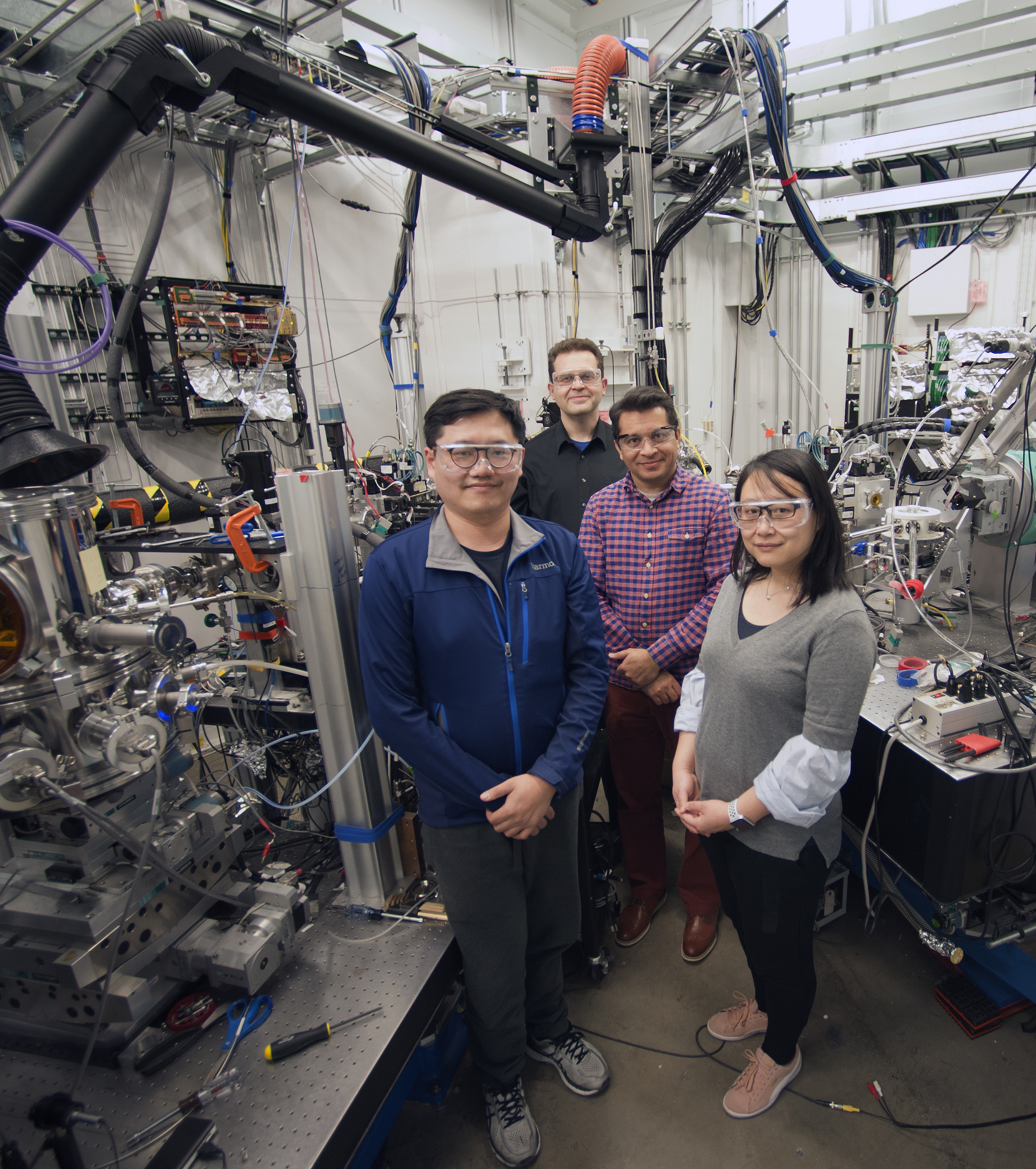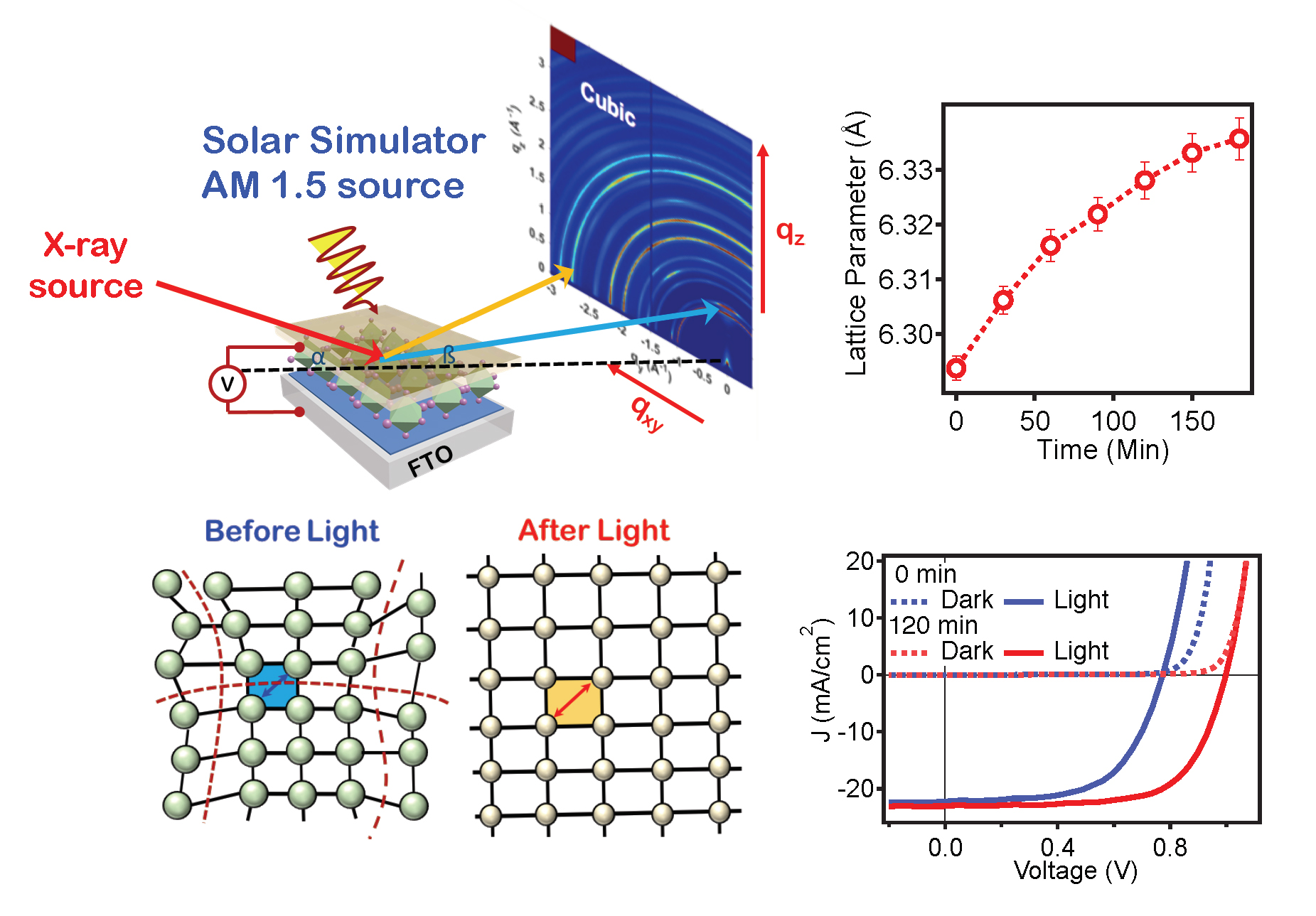 One of the most vital areas of research in the quest for better and cheaper photovoltaic devices centers on hybrid materials based on a perovskite structure. But while many promising compounds have been identified, the realization of truly efficient and commercially viable perovskite-based solar cells continues to be hampered by several factors, including material stability and fragility problems in varying environmental conditions. A university-national laboratory team of researchers has found a promising solution to those problems in a perovskite compound that actually expands under illumination, smoothing out defects in its crystal lattice and allowing more efficient charge transport across the interface, with improved power conversion efficiency (PCE) to over 20%. Their work, based in part on research at the U.S. Department of Energy’s Advanced Photon Source (APS), appeared in the journal Science.
One of the most vital areas of research in the quest for better and cheaper photovoltaic devices centers on hybrid materials based on a perovskite structure. But while many promising compounds have been identified, the realization of truly efficient and commercially viable perovskite-based solar cells continues to be hampered by several factors, including material stability and fragility problems in varying environmental conditions. A university-national laboratory team of researchers has found a promising solution to those problems in a perovskite compound that actually expands under illumination, smoothing out defects in its crystal lattice and allowing more efficient charge transport across the interface, with improved power conversion efficiency (PCE) to over 20%. Their work, based in part on research at the U.S. Department of Energy’s Advanced Photon Source (APS), appeared in the journal Science.
Much of the work on perovskite materials has followed a somewhat trial-and-error approach, combining different materials into a perovskite ABX3 structure and testing the characteristics of the resulting compound. Prior studies have demonstrated that light soaking of certain materials could induce structural changes that improve photovoltaic efficiency, but detailed in situ information that could help researchers better understand, and perhaps tailor the phenomenon has been lacking.
In the present work, the team from Los Alamos National Laboratory, Rice University, Purdue University, Northwestern University, Institut FOTON CNRS UMR 6082 (France), and Argonne National Laboratory fashioned a number of hybrid perovskite solar cells with a FA0.7MA0.25Cs0.05PBI3 composition and measured them using a variety of techniques including grazing-incidence wide-angle x-ray scattering (GIWAXS) maps at the X-ray Science Division 8-ID-E x-ray beamline of the APS (an Office of Science user facility at Argonne).
 In most of the cells, the researchers noted a substantial improvement in PCE from 18.5% to 20.5% under continuous light soaking with a 1-sun (100 mW/cm2) source as the lattice structure of the hybrid cells uniformly expanded (Fig. 1). This expansion relieved local strains in the bulk material and better aligned the crystal planes, as evidenced by narrowing and uniform shifting of the Bragg peaks toward lower scattering values as seen by GIWAXS. The researchers explain that constant illumination generates electron-hole pairs in the perovskite material, decreasing the distortions of some bonds while elongating others, resulting in a generalized lattice expansion and relaxation. A similar phenomenon was seen with pure MAPbI3 thin films, suggesting that such lattice expansion under light is common for hybrid perovskite materials.
In most of the cells, the researchers noted a substantial improvement in PCE from 18.5% to 20.5% under continuous light soaking with a 1-sun (100 mW/cm2) source as the lattice structure of the hybrid cells uniformly expanded (Fig. 1). This expansion relieved local strains in the bulk material and better aligned the crystal planes, as evidenced by narrowing and uniform shifting of the Bragg peaks toward lower scattering values as seen by GIWAXS. The researchers explain that constant illumination generates electron-hole pairs in the perovskite material, decreasing the distortions of some bonds while elongating others, resulting in a generalized lattice expansion and relaxation. A similar phenomenon was seen with pure MAPbI3 thin films, suggesting that such lattice expansion under light is common for hybrid perovskite materials.
The effects of this light-induced lattice expansion improve the photovoltaic characteristics of the perovskite material in several significant ways. Using various techniques, the team observed that the open circuit voltage and fill factor, both crucial parameters of PV performance, are significantly increased upon lattice expansion. Another factor contributing to substantially increased efficiency is considerable suppression and lowering of the energetic barrier at the perovskite-contact interfaces. In an operational solar cell, this would allow easier current flow from the absorber to the electrodes.
Previous experiments with MAPbI3 films demonstrated some changes in contact interfaces following light soaking, which were attributed to ion migration from the perovskite material to the contact. To rule out such effects in the current work, the experimenters performed x-ray photoelectron spectroscopy (XPS) before and after illumination, and also monitored open circuit voltage and fill factor values in darkness while applying a constant bias current. Neither technique showed any evidence of ion migration as seen in the MAPbI3 film experiments.
The lattice expansion persists for at least 30 minutes in the perovskite materials even when the films are rested in complete darkness after illumination. To exclude any possibility that the lattice expansion might be heat-induced, the experimenters maintained the perovskite films at constant temperature during illumination and in darkness. When exposed to greater illuminations of 10-sun intensity, the films maintained their PV efficiency for considerable time, degrading only to 80% after 600 minutes. The investigators also noted that the light-induced lattice expansion had no noticeable effects on the photovoltaic stability of their devices, even after more than 1500 hours of continuous operation under 1-sun illumination.
These findings not only represent a highly significant step forward in the search for stable and practical perovskite-based photovoltaic devices, but also point the way toward new research possibilities in the fundamental understanding of perovskite-based materials and their behaviors. ― Mark Wolverton
See: Hsinhan Tsai1,2, Reza Asadpour3, Jean-Christophe Blancon1, Constantinos C. Stoumpos4, Olivier Durand5, Joseph W. Strzalka6, Bo Chen2, Rafael Verduzco2, Pulickel M. Ajayan2, Sergei Tretiak1, Jacky Even5, Muhammad Ashraf Alam3, Mercouri G. Kanatzidis4, Wanyi Nie1*, and Aditya D. Mohite1,2**, “Light-induced lattice expansion leads to high-efficiency perovskite solar cells,” Science 360, 67 (6 April 2018). DOI: 10.1126/science.aap8671
Author affiliations: 1Los Alamos National Laboratory, 2Rice University, 3Purdue University, 4Northwestern University, 5Institut FOTON CNRS UMR 6082, 6Argonne National Laboratory
Correspondence: * [email protected], ** [email protected]
Work at Northwestern was supported by the U.S. Department of Energy (DOE) Office of Science (grant SC0012541, structure characterization). A.D.M. acknowledges support by U.S. DOE Office of Energy Efficiency and Renewable Energy grant DE-FOA-0001647-1544 for this work. This research used resources of the Advanced Photon Source, a U.S. DOE Office of Science User Facility operated for the DOE Office of Science by Argonne National Laboratory under Contract No. DE-AC02-06CH11357.
Argonne National Laboratory seeks solutions to pressing national problems in science and technology. The nation's first national laboratory, Argonne conducts leading-edge basic and applied scientific research in virtually every scientific discipline. Argonne researchers work closely with researchers from hundreds of companies, universities, and federal, state and municipal agencies to help them solve their specific problems, advance America's scientific leadership and prepare the nation for a better future. With employees from more than 60 nations, Argonne is managed by UChicago Argonne, LLC for the U.S. Department of Energy's Office of Science.
The U.S. Department of Energy's Office of Science is the single largest supporter of basic research in the physical sciences in the United States and is working to address some of the most pressing challenges of our time. For more information, visit the Office of Science website.
